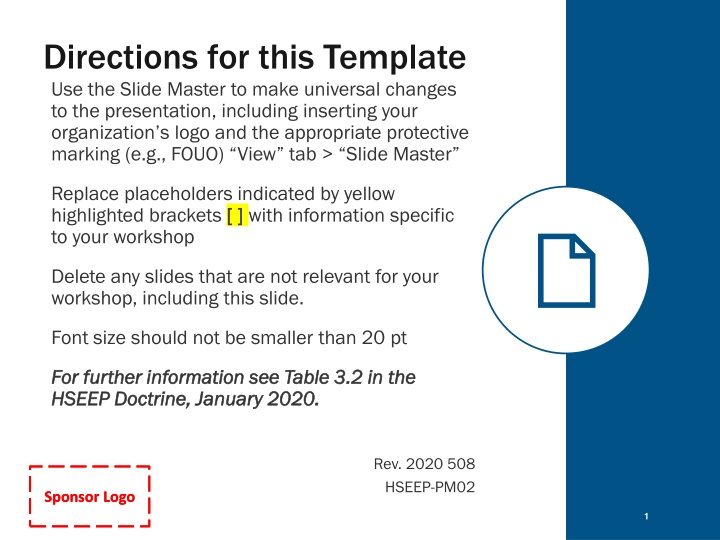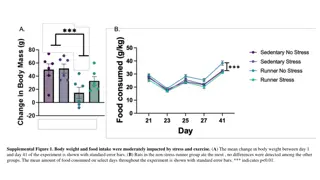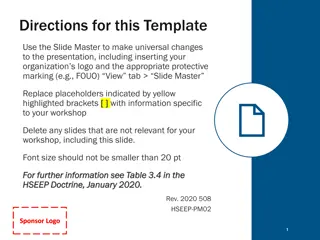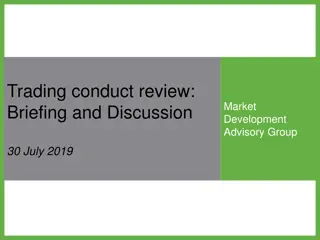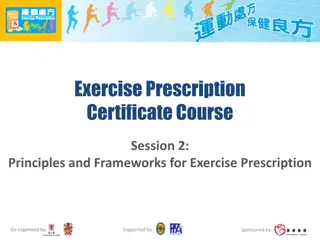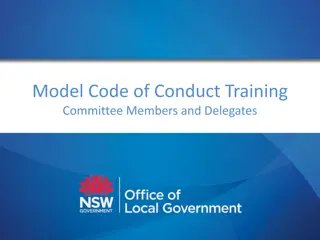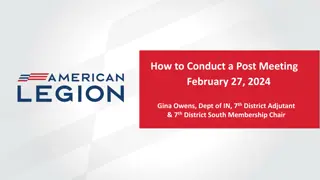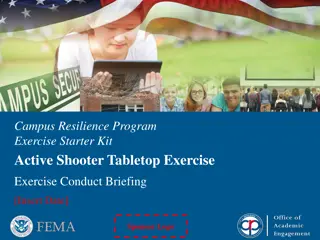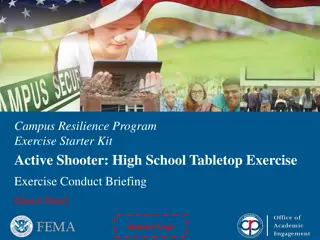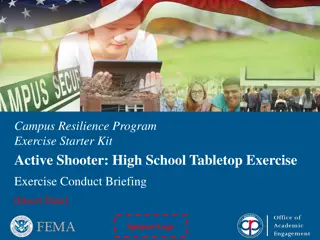Meeting Planning Guidelines for Effective Exercise Conduct
Develop an effective meeting plan for exercise conduct using these guidelines. Utilize the provided templates to structure introductions, administrative remarks, trusted agents' roles, agenda setting, and meeting objectives related to exercise design and development. Ensure clarity in setting objectives, aligning capabilities, addressing scenario variables, and assigning responsibilities for successful exercise planning.
Download Presentation

Please find below an Image/Link to download the presentation.
The content on the website is provided AS IS for your information and personal use only. It may not be sold, licensed, or shared on other websites without obtaining consent from the author.If you encounter any issues during the download, it is possible that the publisher has removed the file from their server.
You are allowed to download the files provided on this website for personal or commercial use, subject to the condition that they are used lawfully. All files are the property of their respective owners.
The content on the website is provided AS IS for your information and personal use only. It may not be sold, licensed, or shared on other websites without obtaining consent from the author.
E N D
Presentation Transcript
Directions for this Template Use the Slide Master to make universal changes to the presentation, including inserting your organization s logo and the appropriate protective marking (e.g., FOUO) View tab > Slide Master Replace placeholders indicated by yellow highlighted brackets [ ] [ ] with information specific to your workshop Delete any slides that are not relevant for your workshop, including this slide. Font size should not be smaller than 20 pt For further information see Table 3.2 in the For further information see Table 3.2 in the HSEEP Doctrine, January 2020. HSEEP Doctrine, January 2020. Rev. 2020 508 HSEEP-PM02 Sponsor Logo Sponsor Logo 1
Initial Planning Meeting (IPM) Exercise Name [Date] Sponsor Logo Sponsor Logo Sponsor Logo
Welcome and Introductions [Name] [Title (e.g., Exercise Director or Lead Planner) [Jurisdiction/Organization] Sponsor Logo Sponsor Logo 3
Administrative Remarks Safety and emergency information Restrooms Cell phone etiquette Breaks and lunch Microphones (if applicable) Sponsor Logo Sponsor Logo 4
Trusted Agents Trusted agents are the individuals on the Exercise Planning Team(s) who are trusted not to reveal exercise and scenario details to players or third parties before exercise conduct. Trusted agents also develop pre-exercise materials, conduct exercise briefings, and support training sessions. Information in this document is intended for the exclusive use of the exercise planners and is not to be released to the public or other personnel who do not have a valid need-to-know without prior approval from an authorized sponsor organization representative. This document is not releasable to any public website. Sponsor Logo Sponsor Logo 5
Agenda [Time] Welcome and Introductions [Time] Planning Updates [Time] Exercise Design [Time] Exercise Development [Time] Outstanding Issues [Time] Action Items and Next Steps Sponsor Logo Sponsor Logo 6
Meeting Objectives Exercise Design Exercise Design Clearly defined objectives and aligned capabilities Initial capability targets and critical tasks Scenario variables (threat, scope, venue, conditions) and vetting Participating organizations and extent of play Exercise documentation development Exercise Development Exercise Development Identified and assigned responsibilities for logistics Exercise Staffing/planning team Exercise planning timeline Discuss next steps and assign tasks Discuss next steps and assign tasks Sponsor Logo Sponsor Logo 7
Planning Updates [Outcomes of the Concept and Objectives Meeting] [Additional updates] Sponsor Logo Sponsor Logo 8
Exercise Design Discussion Points Objectives and Aligned Capabilities Scenario Evaluation Requirements Plans, Policies, and Procedures Exercise Participants Exercise Documentation Local Issues or Concerns Sponsor Logo Sponsor Logo 9
Objectives and Aligned Capabilities Objective: [Proposed Objective] Aligns to: [Capability] Objective: [Proposed Objective] Aligns to: [Capability] Objective: [Proposed Objective] Aligns to: [Capability] Sponsor Logo 10
Evaluation Requirements Capability targets Capability targets are the performance thresholds for each capability Targets are quantitative or qualitative Critical tasks Critical tasks are the distinct elements required to perform a capability Exercise Evaluation Guides Exercise Evaluation Guides (EEGs) document exercise objectives, capabilities, capability targets, and critical tasks Sponsor Logo Sponsor Logo 11
Plans, Policies, and Procedures [Relevant plans, policies, and procedures to be tested or examined during the exercise] Sponsor Logo Sponsor Logo 12
Scenario The scenarios enables an exercise to assess objectives and capabilities Threat or Hazard: [Proposed threat/hazard] Conditions: [Scenario details such as locations, time, weather, etc.] Modeling and Simulation: [Any models or simulations to be used] Human-based Computer-based Subject-Matter Experts (SMEs) Sponsor Logo Sponsor Logo 13
Exercise Participants Participating Participating Organization Organization [Participating organization] Role Role Extent of Play Extent of Play [Role (e.g., Player, Observer)] [Role (e.g., Player, Observer)] [Role (e.g., Player, Observer)] [Role (e.g., Player, Observer)] [Extent of play] [Participating organization] [Extent of play] [Participating organization] [Extent of play] [Participating organization] [Extent of play] Sponsor Logo 14
Exercise Documentation Identify required documentation: Extent of Play Agreement (XPA) EEGs Situation Manual (SitMan) [discussion-based] Facilitator Guide [discussion-based] Exercise Plan (ExPlan) [operations-based] Controller/Evaluator (C/E) Handbook [operations-based] Master Scenario Events List (MSEL) [operations-based] Multimedia Presentation Participant Feedback Form Sponsor Logo Sponsor Logo 15
Local Issues or Concerns [Any issues, concerns, or sensitivities for discussion and consideration] Sponsor Logo Sponsor Logo 16
Exercise Design Discussion Points Exercise Logistics Exercise Schedule Exercise Staffing Exercise Planning Team Exercise Planning Timeline Sponsor Logo Sponsor Logo 17
Exercise Logistics Exercise Location: [Venue arrangements, including location(s), setup, etc.] [Any designated exercise area, i.e. observer/media area] A/V Requirements: [A/V arrangements, i.e. screens, microphones] Supplies, Food, and Refreshments Badging and Identification [Table/Breakout Identification] [Badging and identification arrangements] Parking and Transportation [Parking and transportation arrangements] Media, Public Affairs, and VIPs Sponsor Logo Sponsor Logo 18
Exercise Schedule Location Location (if needed) (if needed) [Location] Event Event Date Date Controller/Evaluator Brief [Date] Participant Registration Participant Brief Start of Exercise (StartEx) End of Exercise (EndEx) Hotwash Controller/Evaluator Debrief [Date] [Date] [Date] [Date] [Date] [Date] [Location] [Location] [Location] [Location] [Location] [Location] Sponsor Logo 19
Exercise Staffing Exercise Control Lead or Senior Controller: [Name/organization] Safety Controller: [Name/organization] [Other controllers as needed] Exercise Evaluation Lead Evaluator: [Name/organization] [Site- or function-specific evaluators, as needed] Other Exercise Support/Subject-Matter Experts [Any identified SMEs] [Other Staff As Needed] Sponsor Logo 20
Exercise Planning Team Roles and Responsibilities Roles and Responsibilities [Planning team roles and assignments] Communications Communications [Preferred frequency and methods of communications] Sponsor Logo 21
Exercise Planning Timeline Location Location (if needed) (if needed) [Location] [Location] [Location] [Location] Event Event Date Date Midterm Planning Meeting MSEL Meeting Final Planning Meeting Exercise Draft AAR After-Action Meeting Final AAR/IP [Date] [Date] [Date] [Date] [Date] [Date] [Date] [Location] Sponsor Logo 22
Outstanding Issues [Any outstanding issues to address] Sponsor Logo 23
Action Items Distribute IPM minutes: [Responsible jurisdiction/organization/individual], [due date] Draft exercise documentation EEGs: [Responsible jurisdiction/organization/individual], [due date] [Other documents as needed] [Additional action items] Sponsor Logo 24
Next Meeting [DATE] [TIME] [LOCATION] Sponsor Logo 25
